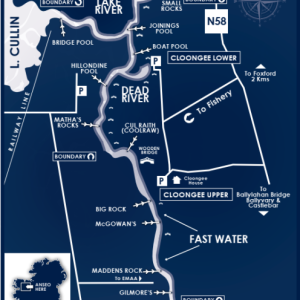Cloongee Fishery
The Cloongee Fishery is one of the most prolific fisheries on the River Moy with historical catches up to 800 salmon per season. It is also well known as a fishery that performs well early in the season. It is managed by Inland Fisheries Ireland-Ballina and offers a variety of quality Angling.
The Fishery consists of over 3 miles of both double and single bank stretches. It is situated 1.5 miles South of Foxford off the N58 Foxford to Castlebar Road.
Permits are available from the 1 February .
Multiple Day permits available form the 16th March to the end of season.
½ Day permits are available for the period 16 March to 31 July only. [½ Day 6am to 2pm or 2pm to dark]
Permits must be purchased before attending to fish
The lower part of the Cloongee Fishery will suit all angling methods in a variety of water conditions, while much of the upper stretch has good fast fly water and fishes best on a falling flood.
The lower part of the fishery is all double bank, except for a short stretch of single bank at Carrigeen. It includes the Lake River and the Joinings, which is considered by many to be the most productive part of the fishery. Carrigeen and Com are also well known throughout the area as excellent salmon pools.
When water levels are low the fly can be used in the Bridge Pool at the head of the Lake river & at the head of the Joinings Pool. The upper stretch of the fishery is approximately 60% single bank and the top section of this stretch, from the boundary drain to the wooden bridge, may be restricted to fly fishing only at certain levels as this area is considered excellent fly water.
Further downstream on this stretch, Hallodines and Matha’s Rocks offer excellent angling to worm and spinner and are noted as particularly good pools for bubble & fly on a breezy day.
Safety
In the interest of safety, anglers are advised to take special care when fishing. The following guidelines should be adhered to at all times:
- Whether bank fishing, wading or fishing from a boat, anglers should always wear a Personal Flotation Device.
- Anglers should take care on slippery banks and rocks.
- Use a wading staff for support and for locating hidden hazards.
- Care should be taken when casting, particularly when back casting.
Showing all 6 results
-

Cloongee Fishery – Day Permit
€20.00 (starting from) -

Cloongee Fishery – Half Day Permit AFTERNOON
€30.00 -

Cloongee Fishery – Half Day Permit MORNING
€30.00 -

Cloongee Fishery – Juvenile Day Permit
€10.00 -

Cloongee Fishery – Multi Day Permits August to September
€60.00 (starting from) -

Cloongee Fishery – Multi Day Permits March to July
€70.00 (starting from)
